串的定义及基本运算
- 格式:ppt
- 大小:108.50 KB
- 文档页数:29


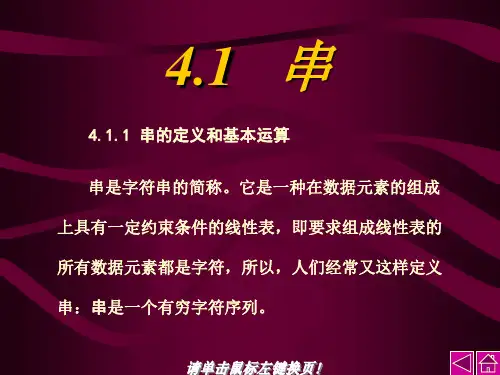
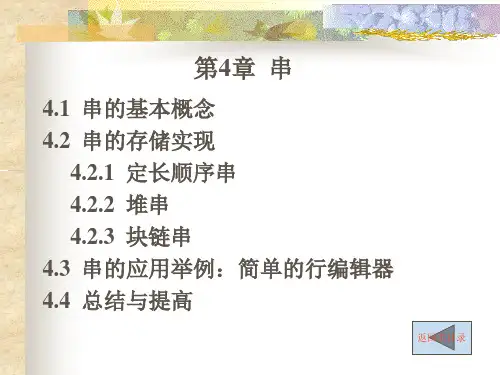

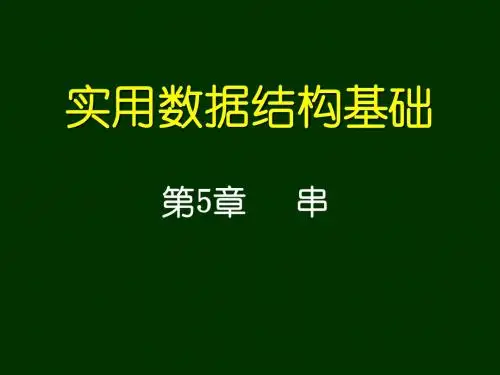
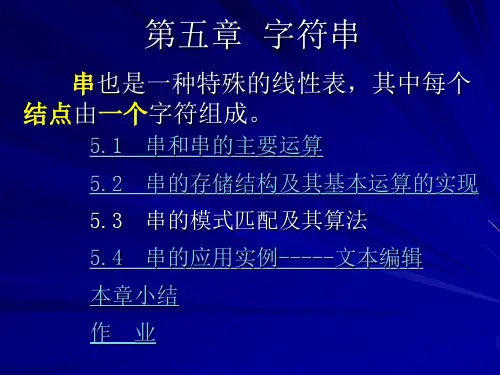


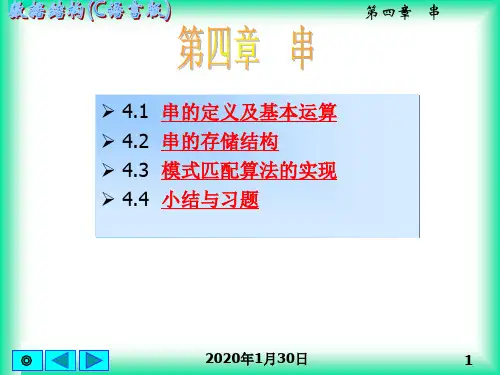

1上机实训3:串的基本操作一、实训目的通过实训,掌握串的运算(赋值,比较,联结,插入子串,模式匹配……等)二、实验理论知识1)串的基本概念及其含义串( string)是由零个或多个字符组成的有限序列,一般记作:s='a1a2…an'(n≥0),其中s为串的名字,用单引号括起来的字符序列为串的值;ai(1≤i≤n)可以是字母、数字或其它字符(取决于程序设计语言所使用的字符集);n为串中字符的个数,称为串的长度。
2)串的存储表示及其实现●顺序存储可以用一组地址连续的存储单元依次存放串的各个字符,这是串的顺序存储结构,也称为顺序串●链式存储和线性表的链式存储结构相类似,也可采用链表方式存储串值。
串的这种链式存储结构简称为链串。
用链表存储字符串,每个结点需要有两个域:一个数据域(data)和一个指针域(Next),其中数据域存放串中的字符,指针域存放后继结点的地址。
3)模式匹配问题三、实训案例与分析【实例1】串的存储与基本运算【实例分析】在本实例中练习计算字符串的长度、字符串的复制、字符串的比较、字符串的连接、字符串的插入等基本操作。
在设计时1)编写一个菜单函数,根据不同情况做(1-5)不同选择。
2)如果选择1,即要求计算输入字符串的长度。
3)如果选择2,完成字符串的复制。
4)如果选择3,完成字符串的比较。
5)如果选择4,完成两个字符串的连接。
6)如果选择5,字符串的插入。
【参考程序】#include <stdio.h>#define MAX 128typedef enum {fail,success} status;typedef enum {false,true} boolean;main(){ int strlen();void strass();boolean strcmp();status strcat( );status strins();int t,n,i;boolean b;status st;char s[MAX],s1[MAX],s2[MAX];printf("\n1. The length of string\n");printf(" 2. The assignment of string\n");printf(" 3. A string compare with another string:\n"); printf(" 4. A string connect with another string:\n"); printf(" 5. A string to be inserted into another string\n"); printf(" Please input a operation:");/*输入操作选项*/ scanf("%d",&t);switch(t){case 1:printf("please input a string:\n");getchar();gets(s);n=strlen(s);printf("the length is: %d",n);break;case 2:printf("please input the first string:\n");getchar();gets(s1);printf("please input the second string:\n");getchar();gets(s2);strass(s1,s2);break;case 3:printf("please input the first string:\n"); getchar();gets(s1);printf("please input the second string: \n"); gets(s2);b=strcmp(s1,s2);if (b==true)printf("equal\n");elseprintf("not equal\n");break;case 4:printf("please input the first string:\n"); getchar();gets(s1);printf("please input the second string:\n"); gets(s2);st=strcat(s1,s2);if(st==success)printf("answer is %s\n",s1);elseprintf("error!\n");break;case 5:printf("please input the first string:\n"); getchar();gets(s1);printf("please input the second string:\n"); gets(s2);printf("please input i:");scanf("%d",&i);st=strins(s1,i,s2);if(st==success)printf("answer is: %s\n",s1);else printf("error!\n");break;case 0:break;default: printf("There isn't this operation!");}}int strlen(s) /*求字符串的长度子函数*/char s[];{ int i;for(i=0;s[i]!='\0';i++);return (i);}void strass(s1,s2)char s1[],s2[];{ int i=0;while(s1[i]!='\0'){ s2[i]=s1[i];i++;}s2[i]='\0';printf("s2 is %s",s2);}boolean strcmp(s1,s2) /*字符串比较子函数*/ char s1[],s2[];{ int i=0;while (s1[i]==s2[i] && s1[i]!='\0' && s2[i]!='\0') i++;if (s1[i]=='\0' && s2[i]=='\0')return (true);elsereturn (false);}status strcat (s1,s2) /*字符串连接子函数*/char s1[],s2[];{ int i,j,k;i=strlen(s1);j=strlen(s2);if((i+j)>=MAXN)return(fail);for(k=0;k<=j;k++)s1[i+k]=s2[k];return (success);}status strins (s1,i,s2)char s1[],s2[];int i;{ int m,n,k;m=strlen(s1);n=strlen(s2);if (i<0||i>m||(m+n)>MAXN )return (fail) ;for(k=m;k>=i;k--)s1[k+n]=s1[k];for(k=0;k<n;k++)s1[i+k]=s2[k];return (success);}【测试数据与结果:】计算字符串的长度1. The length of string2. The assignment of string3. A string compare with another string:4. A string connect with another string:5. A string to be inserted into another string Please input a opertation:1please input a string:you are a boy!the length is: 14字符串的复制1. The length of string2. The assignment of string3. A string compare with another string:4. A string connect with another string:5. A string to be inserted into another string Please input a opertation:2please input the first string:you are a boy!please input the second string:i am a girl!s2 is you are a boy!字符串的比较1. The length of string2. The assignment of string3. A string compare with another string:4. A string connect with another string:5. A string to be inserted into another string Please input a opertation:3please input the first string:you are a boy!please input the second string:i am a girl!not equal字符串的连接1. The length of string2. The assignment of string3. A string compare with another string:4. A string connect with another string:5. A string to be inserted into another stringPlease input a opertation:4please input the first string:you are a boy!please input the second string:i am a girl!answer is:you are a boy!i am a girl!字符串的插入1. The length of string2. The assignment of string3. A string compare with another string:4. A string connect with another string:5. A string to be inserted into another stringPlease input a opertation:5please input the first string:you are a boy!please input the second string:i am a girl!please input i:2answer is i am a girl! you are a boy!【实例2】统计主串指定单词在主串中出现的次数和位置【实例描述】统计主串指定单词在主串中出现的次数和位置,要求:1)输入以回车作为结束符的一串字符作为主串;2)求主串中指定单词出现的次数和位置,注意单词与子串的区别;【实例分析】假设num存放出现次数,初始化为0,position[i]存放每一次匹配时的位置。
Chapter 4 串4.1 串的定义及其运算4.2 串的表示和实现4.3 串的模式匹配算法4.4 串的应用——文本编辑本章重点:1. 串的定义及基本操作的确切含义。
2. 串的存储结构(顺序、链式)的描述方法。
3. 串的模式匹配算法,尤其是KMP 算法中next 函数的定义及如何计算给定模式串的next 函数值。
本章难点:1. 在串的顺序存储结构上实现串的各种操作的方法。
2. 串匹配的KMP 算法。
4.1 串的定义及其运算一、串的基本概念1.字符(Char ):字母、数字、其它符号。
2.串(String ):由n(n ≥0)个字符组成的有限序列。
记为:S=“a 0a 1…a n-1”。
其中,S 是串的名,称为串名,a 0a 1…a n-1是串的值,称为串值。
串中字符的数目称为串的长度。
名值名值A=“1234”S=“abcde”例:注意:双引号“和”不属于S 的值,其作用只是为了避免与其他符号混淆。
3.空串(Null String ):不含任何字符的串。
用“”或Φ表示。
其长度为0。
4.空格串(Blank String ):仅含空格字符的串(即由一个或多个空格字符组成的串)。
例:长度为2的空格串记作“”或“φφ”5.子串(Substring ):串中的一个连续字符子序列叫做该串的一个子串。
对应地,该串就称为主串。
例:A=“123456”,B=“456”,C=“46”B 为A 的子串,A 为主串;C 不是A 的子串。
二、串的基本运算1.初始化Initiate(S)2.赋值Assign(S, T)例:T=“DATA”,则执行Assign(S,T)后,S 的值就等于“DATA”。
注:后一个参数可为串变量名,也可为字符序列。
3.求长度Length(S)4.比较Compare(S, T)比较结果有三种:S 大于T ,S 等于T ,S 小于T 。
5.插入Insert(S, pos, T)若0≤pos ≤Length(S),则在串S 的第pos 个字符之前插入串T ,串S 的新长度为Length(S)+Length(T)。